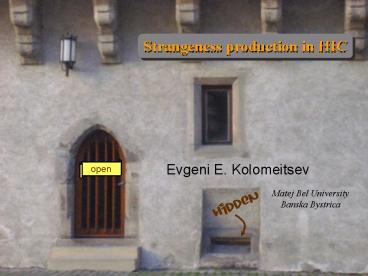Strangeness production in HIC - PowerPoint PPT Presentation
1 / 32
Title:
Strangeness production in HIC
Description:
Strangeness' Hall of Fame. 2. Temporal aspects of the strangeness production: ... Strangeness in HIC: Hall of Fame. most popular pictures (personal choice) 2006. 1998 ... – PowerPoint PPT presentation
Number of Views:33
Avg rating:3.0/5.0
Title: Strangeness production in HIC
1
Strangeness production in HIC
Evgeni E. Kolomeitsev
open
Matej Bel University Banska Bystrica
hidden
2
(No Transcript)
3
Strangeness in HIC Hall of Fame
most popular pictures (personal choice)
4
Antikaon production
KaoS Collaboration
2006
in-medium modifications of kaon properties
5
Kaon production
NA49 Collaboration
The Horn
Difficult to reproduce transport generators
(RQMD, HSD) hydro calculations statistical
model
Successful interpretation within the Statistical
model of the early stage Gazdzicki
Gorenstein
Evidence for a QGP phase transition?
6
Phi meson puzzle
1997-1999
NA49/NA50 Collaborations
Difference of phi yields in PbPb_at_158
AGeV NA49 (??K K-) and NA50 (????) experiments
rescattering of decay products
2006-2008
CERES 06 in PbAu_at_158AGeV Phi yield via ??ee-
agrees with NA49 data
NA60 08 in InIn_at_158 AGeV ???? Phi yield is
higher than in NA49
7
Resonance production at RICH
Thermal model THERMUS Wheaton Cleymans 04
STAR vs. Thermal model
Continuous freeze-out Grassi, Kadama, Knoll ..
STAR AuAu_at_ 200 AGeV R. Witt JPG 34 (2007) S921
8
Why do we like strange particles?
- particles with a tag (new quantum number)
- mass gap
- associated particle production
The strangeness production in a HIC is controlled
by
- available energy (energy density) and mass gap
(in medium) - - temporal evolution of a HIC (fireball lifetime)
9
open strangeness
10
energy vs. time
We try hadronic scenario
intrinsically assume non-equilibrium of
strangeness.
B.Tomasik,E.E.K, nucl-th/0512088 EPJC 49 (2007)
11
flavour kinetic calculation with an ansatz for
the fireball expansion
parameterize the space-time evolution
a data/experience (HBT, spectra) driven ansatz
for expansion
We want to explore various ansatzes and their
impact on result
K and K0 evolution calculated from
calculate from known cross-sections and evolved
densities
12
- explicit kinetic calculation K, K0, K, K0
(vacuum properties) - kaons in thermal equilibrium (until decoupling)
- chemical equilibrium non-strange species (?, N,
?, ?, N,) - relative chemical equilibrium Slt0 sector ( K-,
?, ?, ?, ?) - no antibaryons assumed at these energies
in red well-defined cross sections
13
acceleration power-law expansion
- explore a range of values for the model
parameters - at the end power-law scaling suggested by HBT
14
initial K content estimated from pp (pn, nn)
collisions initial Slt0 species balance
strangeness and are relatively equilibrated
we certainly end up with correct ?FO, ?B,FO,
?I,FO but temperature
depends on strangeness production
15
for a given run
FO analysis
for a given run
the power-law prescription is realized only
towards the end
16
exp. data
17
the whole final chemical composition is correct!
18
(No Transcript)
19
The K horn can be interpreted as a rise and fall
of the fireball lifetime
The time needed for a strangeness production is
about 15-20 fm/c. In hydro the typical
expansion time is lt10 fm/c.
20
hidden strangeness
21
Okubo-Zweig-Iizuka suppression rule
the interactions of a pure (ss) vector state with
non-strange hadrons are suppressed
1/Nc counting
?
3 times smaller than expected from pure
octet-singlet mixing ??? coupling due to the
anomaly
Experiment
22
Phi production in reactions involving strange
particles is not OZI suppressed!
strangeness hides into ?
a new type of the ? production mechanism
catalytic phi meson production
strangeness content does not change
23
traditional
catalytic
dominant source of phi considered so far
typical hadronic cross sections
Andronic, PBM, Stachel, NPA 772, 167
24
Cross section of catalytic reactions
isospin averaged cross sections
Cross sections 1 mb much
larger than ? N-gt? N
25
Simple model for strangeness production
Diff.eq. for K production
annihilation neglected, ?Kltlt?B
thermal weights
scales with t0 !
26
Phi production
27
Centrality dependence
Consider a collision at some fixed energy
(? - reaction rate)
catalytic reactions
28
Centrality dependence
fit coefficients to data point
E917 Collaboration, PRC 69 (2004) 054901
AuAu_at_11.7 AGeV
The catalytic reaction contribution can be about
30-40 for NppA.
29
Phi rapidity distribution
The distributions can be fitted with a sum of two
Gaussian functions placed symmetrically around
mid-rapidity
NA49 Collaboration, PRC 78 (2008) 044907
30
Assume the rapidity distributions of particles
do not change after some initial stage.The
absence or weakness of acceleration and diffusion
processes. The collision kinematics is
restricted mainly to the exchange of transverse
momenta . The rapidity distribution of ?s
produced in the reaction 12 -gt ? X is roughly
proportional to the product of rapidity
distributions of colliding particle species 1 and
2.
31
Catalytic phi production
can be competitive if Tgt110 MeV and t_0gt10 fm
can be seen in centrality dependence of the phi
yield
determine the width of the phi rapidity
distribution
32
What to measure?
just K mesons deadly boring
K and K-- mesons boring
kaons and ? check for strangeness conservation
kaons mesons and ? and ? check for
strangeness conservation
isospin
kaons mesons and hyperons and ? interesting
kaons mesons and hyperons and ? and ? very
interesting
strangeness
dynamics
kaons mesons and S1,2 hyperons and ? and
hyperon resonances
exciting































